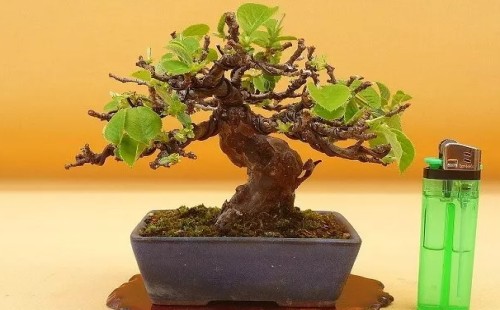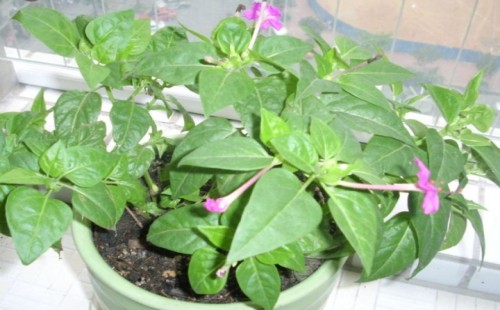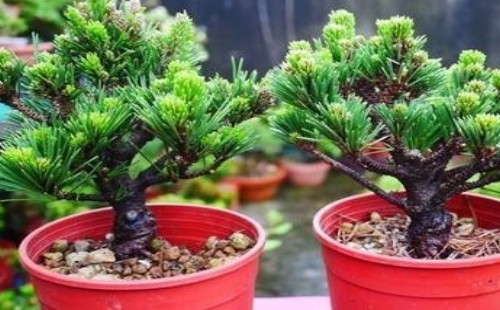Maintenance skills of papaya bonsai
Papaya bonsai not only has high ornamental value, but also has great edible value, so making papaya into a potted plant is both beautiful and practical. Therefore, when we have a pot of papaya bonsai, maintenance and management must be done to ensure that the beauty of bonsai is sustainable. So, how to maintain the papaya bonsai? In order to help potted friends manage their own papaya bonsai, today the editor will share with you the conservation skills of papaya bonsai.

The transplanting of papaya seedlings is usually carried out in spring, and transplanting in early spring has a higher survival rate. However, when transplanting into the pot, it should be carried out with soil, and at the same time, it is necessary to trim the root properly, mainly to cut the main root and retain the lateral root and fibrous root as much as possible. When putting into the basin, it is recommended to bury enough rotten cake fertilizer as base fertilizer in the basin, and then move it to a place with sufficient outdoor light for management after it has been successfully planted and grown stably. Plants in the growing period need to keep the basin soil moist to promote growth, but at the same time to avoid stagnant water in the basin, especially in rainy days to take good drainage and waterlogging prevention measures.
In the early April of spring, topdressing is usually needed in order to ensure that the plant can maintain normal growth. After all, as a potted plant, the amount of soil in the basin is limited, and the nutrients are more limited, so topdressing is needed in time. At the beginning of the period, an appropriate amount of potassium dihydrogen phosphate diluent can be sprayed, and the concentration should be controlled at about 0.2%. Through reasonable application of foliar fertilizer, it can effectively promote the pregnant buds, make the buds grow stronger and fuller, and save enough nutrients for the fruit hanging in the later stage.
At the same time, due to the limitation of the capacity in the basin, the nutrients are very limited, and the number of fruits should not be too much, otherwise there will not be enough nutrients to support the formation and expansion of the fruit, which will seriously reduce the quality of the fruit. Usually each pot of papaya tree can retain 3-5 fruits, the rest of the fruit should be removed in time. The main purpose of this is to avoid hanging too many fruits and making the limited nutrients too scattered, thus weakening the tree potential, which is not conducive to the growth and ripening of the fruit.
Of course, it is also recommended to apply thin alum fertilizer once a month to prevent the basin soil from becoming alkaline, because papaya prefers to grow in acidic soil. Another function of applying some alum fertilizer and water is to improve the quality of the fruit, make the fruit stronger and taste better at the same time. However, do not topdressing concentration, raw fertilizer, otherwise not only not conducive to papaya tree blossom and fruit, but also may cause fertilizer damage, root rot phenomenon, seriously affect the growth of plants.
At the same time, in the process of maintenance and management of papaya bonsai, we also need to take into account the appreciation of bonsai, so during the original maintenance, we need to carry out timely coring and multiple coring treatment to ensure that the plant can maintain a good plant type effect. at the same time, enhance the ornamental value of bonsai. In the deciduous season in winter, we also need reasonable pruning and shaping of papaya trees, mainly to cut off the weak twigs, withered branches and other branches that affect the appearance. At the same time, leave more strong branches with good growth, so as to promote flowering and fruiting in the later stage.
Papaya is a kind of fruit tree with strong cold tolerance, so it can be put in outdoor maintenance and management in winter, but it is recommended to be placed in a sunny place to ensure that freezing injury will not occur and survive the winter smoothly. However, if the outdoor temperature is too low, especially near the northern area, it is recommended to bury the flowerpot underground, you can also move indoors. As long as the indoor temperature can be kept above 0 ℃, it can generally survive the winter safely.
However, the indoor temperature should not be too high, and it is appropriate to keep it below 10 ℃, otherwise papaya trees are easy to sprout ahead of time and cause poor growth in the coming year. As for the papaya bonsai placed indoors, as long as the indoor temperature can be kept between 0 ℃-10 ℃. Because the plants usually go into dormancy in this temperature range, and there is no freezing injury, which creates good conditions for papaya trees to survive the winter smoothly.
In addition, in the process of maintenance and management of papaya bonsai, it is usually necessary to turn the basin in time after 1-2 years of cultivation, in order to improve the looseness and permeability of potted soil, improve the permeability after irrigation and fertilizer, and improve the utilization rate of nutrients. The basin turning work should be carried out in spring every year, and the effect is the best in early spring. And the process of turning the basin is similar to the process of transplanting the seedlings in the pot, so I won't repeat it here.
Time: 2019-05-29 Click:
- Prev

Culture method of potted Thunder Flower
Landmine flowers mostly adopt the way of spring sowing to breed young plants. because of their tenacious vitality and strong ability to adapt to the environment, this kind of flower plant has a strong self-sowing ability and is widely used in landscaping and courtyard beautification. But Thunder flowers can also be potted, every summer and autumn.
- Next

How to Care for Qianshou Pill Bonsai
Senshou maru black pine is a variant of Shousong, its pine needles are shorter than Shousong, but its ability to withstand shade germination is stronger. Usually, the length of pine needles kept within 25 mm has excellent ornamental effect, which is very suitable for making low-grade bonsai for viewing and has extremely high artistic value. So, how do you maintain the Qianshou Pill bonsai?
Related
- Fuxing push coffee new agricultural production and marketing class: lack of small-scale processing plants
- Jujube rice field leisure farm deep ploughing Yilan for five years to create a space for organic food and play
- Nongyu Farm-A trial of organic papaya for brave women with advanced technology
- Four points for attention in the prevention and control of diseases and insect pests of edible fungi
- How to add nutrient solution to Edible Fungi
- Is there any good way to control edible fungus mites?
- Open Inoculation Technology of Edible Fungi
- Is there any clever way to use fertilizer for edible fungus in winter?
- What agents are used to kill the pathogens of edible fungi in the mushroom shed?
- Rapid drying of Edible Fungi

